Timeline - Department of Psychiatry
This timeline was created to commemorate the 75th Anniversary of the Department of Psychiatry and will continue to showcase significant events in our history.
Laying the Foundation
1925 -1926

The Hospital Opens
The medical school opened in 1925, and Strong Memorial Hospital opened its doors as a 250-bed community facility. Read more about the history of the URMC.
Frances Parsons, PhD, joined the Medical School faculty in 1926, one year after the school opened, as the first psychologist and woman to be appointed to the faculty.
Dr. Parsons served as Instructor in Pediatrics and then in Medicine until 1946 when John Romano asked her to join the Psychiatry faculty as the first psychologist in the newly formed department. She retired as Senior Clinical associate in 1966, after many years of teaching and supervising medical and nursing students as well as psychology trainees and psychiatric residents. She also was an active and productive researcher and did ground-breaking research on the effects of sectioning of the corpus callosum. Read more.
1927 -1928

The 1st University of Rochester Psychiatric Inpatient Unit
Outpatient Clinics established with a Foreshadowing of Forensic Psychiatry
The first Psychiatric inpatient unit associated with the University of Rochester and the School of Nursing opened on February 15, 1927, and outpatient clinics added services in 1928.
The inpatient units were located on X-3 of the Municipal Hospital, including 16 single patient rooms arranged along one corridor with a large solarium.
As a division in the Department of Medicine, Psychiatry established outpatient clinics collaborating with the Board of Education and Society for the Prevention of Cruelty to Children. In 1928 Outpatient clinics added services to the criminal branch of the city court, foreshadowing of Forensic Psychiatry.
1945

A Generous Benefactor
Helen Woodward Rivas makes a gift to build a psychiatric clinic in the University of Rochester Medical Center and established a trust fund for its operation and maintenance—which continues to sustain the department in many ways.
Helen was the last surviving child of the late Orator F. Woodward, founder of the Genesee Pure Foods company of Le Roy. Much of the Woodward family fortune came from the Jell-O brand established in 1899.
Psychiatry as a Part of Medicine and
a Model for Interdisciplinary Care
1946

The Official Beginning of the URMC Psychiatry Department & Birth of the Biopsychosocial Model
Dr. John Romano and Dr. George L. Engel Founders
Dr. John Romano was the founder and first chairman of the Department of Psychiatry at the University of Rochester School of Medicine and Dentistry from 1946 to 1971. When Dr. John Romano was offered to establish an entirely new psychiatry department in 1946, he invited Dr. George L. Engel to join him in Rochester.
Dr. Romano's influence as a charismatic educator and physician permeated the school and Strong Memorial Hospital for nearly 50 years, from 1946 until his passing in June 1994. Dr. Romano is regarded as a founding father of modern American psychiatry and is recognized worldwide as a reformer of medical education. A caring nature and keen interest in people were evident throughout Dr. Romano’s career. His unwavering commitment to improving the lives of patients, students, peers, family, and friends was remarkable, even in the last days of his life. Dr. Romano championed the idea that dialogue between patient and physician is an integral part of the healing process, which remains a pillar in today’s biopsychosocial model of teaching and patient care at the School of Medicine and Dentistry and Strong Memorial Hospital, and is a hallmark of a Rochester-trained physician.
With dual appointments in psychiatry and medicine. Dr. Engel established a medical psychiatric liaison service staffed primarily by internists, became deeply involved in incorporating psychiatric training in the medical school curriculum, and began his training in psychoanalysis. This training initially occurred with Sandor Feldman in Rochester and then at the Chicago Institute for Psychoanalysis and the New York Psychoanalytic Institute.
In 1953, Dr. Engel began collaborating with Franz Reichsman on the Monica project, a study that extended from Monica's infancy to adulthood. By the mid-1950s, he was one of the leading figures in psychosomatic studies and was prominent in the American Psychosomatic Society, editing its journal (Psychosomatic Medicine). Dr. Engel also began publishing numerous books and articles on the relation of emotion and disease and incorporating these ideas into medical training and clinical practice. Under his direction, the program in Rochester became a leading center in the development of psychosomatic theory and training. The ultimate expression of Dr. Engel's ideas came to be termed the "biopsychosocial model." In 1979, he stepped down from the directorship of the Medical Psychiatric Liaison Group that had flourished under his direction for more than a quarter-century. Dr. Engel passed away in 1999.
Foreshadowing of MIPS: A special clinic is established for psychiatric outpatients for house officers who held joint medicine and psychiatry appointments.
References:
URMC Edward G. Miner Library - Faculty Collections - John Romano and George Engel
Photos:
Romano:
http://hdl.handle.net/1802/1647
http://hdl.handle.net/1802/1645
Engel:
http://hdl.handle.net/1802/2239
1947 - 1949
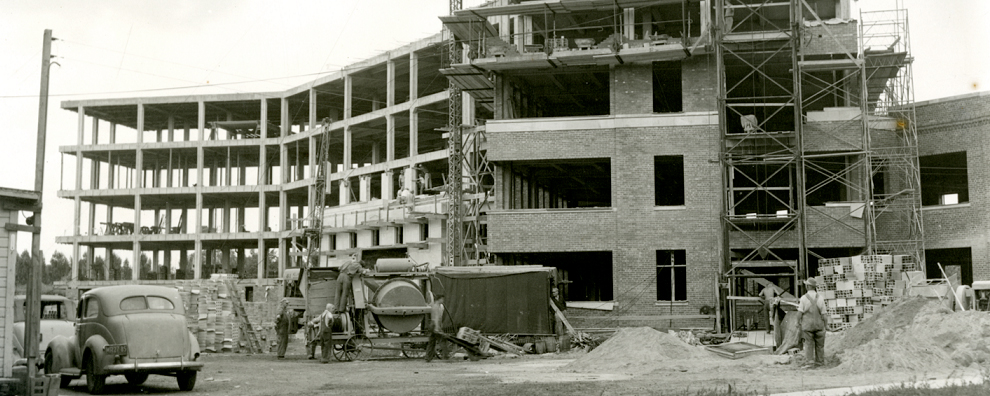
Construction of Wing R Begins
The Beginning of the Psychology Training Programs.
From 1948 to 1949, the Department of Psychiatry “Wing R” was completed. One of the first psychiatric facilities in the nation to be built as an integral part of a university hospital.
With the initiation of the liaison program with Obstetrics, the first inpatient was admitted. Marjorie Harle was appointed Chief Psychiatric Caseworker, and Mildred Fairbanks was appointed to lead Occupational Therapy.
Frances Parson, PhD joins the Department of Psychiatry after becoming, in 1926, the first psychologist and first woman appointed to the UR School of Medicine and Dentistry.
Graduate students from the University of Rochester Department of Psychology began training in the Department in 1947, and postdoctoral training started in 1950 and has been conducted continuously since 1961. The formal pre-doctoral internship program began in 1968 and has been accredited continuously by the APA since 1971.
William Greene, MD was an assistant resident at Strong Memorial Hospital before serving as Commonwealth Fund Fellow in Medicine and Psychiatry at the University of Rochester Medical Center between 1948 and 1950. In 1950, he joined the senior staff of the Medical Psychiatric Liaison Group and was made instructor in Medicine and Psychiatry the same year. Dr. Greene's research focused on the correlation between psychological factors and disease.
1950 -1951
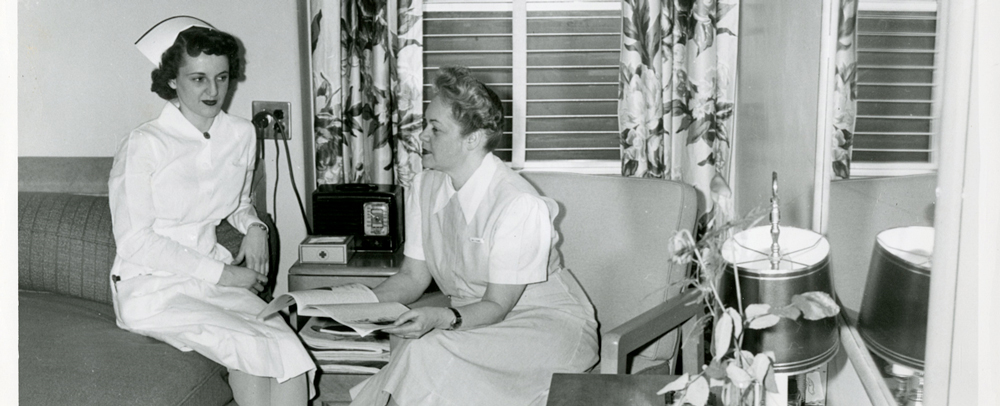
Psychiatric Nursing Education Program Begins
Social Work Education is Initiated
Gertrude A. Stokes, RN, MA, PhD, a graduate of John Hopkins with an M.A. from Teacher’s College, Columbia, became the first psychiatric nursing supervisor and instructor in nursing education in July 1950. She received her PhD in 1970 from New York University. Initiation of assignments of social casework students from Smith College for Social Workers. The first class of medical students in Psychiatry completed training in 1950.
Dr. Stokes’ first task was to develop a graduate psychiatric nursing training program, which she did with funds she received from the Public Health Service and the National Institute of Mental Health under the Mental Health Act of 1946. In 1952, five full-time and three part-time students enrolled and participated in various didactic and clinical aspects of the teaching program. (Romano, Annual Report, 1951-1952). This psychiatric nursing program was described in an article in the American Journal of Nursing in 1956, the first article published by a psychiatric nurse in the UR Dept. of Psychiatry. Didactic courses included Personality Development, Reaction to Illness, and dynamics of interpersonal relationships, emphasizing those of the nurse and the patient. (Stokes, 1956, p. 598).
This advanced psychiatric nursing program was discontinued. Dr. Stokes left in 1956 to take a position as Assistant Professor of Psychiatric Nursing at Wayne State University and worked at the Maimonides Medical Center in New York City. In 1956, the School of Nursing was not a college in the University of Rochester, so faculty positions were unavailable.
Lofthouse, E. M., & Stokes, G. A. (1953). Nursing Care of Children with Cancer. The American Journal of Nursing, 53(4), 415–418. https://doi.org/10.2307/3459656
Stokes, G. A. (1956). Teaching Psychiatric Nursing. The American Journal of Nursing, 56(5), 598–600.
https://doi.org/10.2307/3469319
Stokes, G. A. (1970). A comparison of problem solving in clinical nursing situations by professional and non-professional psychiatric nursing personnel. New York University.
Stokes, G. A., & Fitzpatrick, P. E. (1977). Teaching Students Psychotherapy. The American Journal of Nursing, 77(2), 249–253. https://doi.org/10.2307/3424112
1953 -1954
Conservation Withdrawal Theory
George Engel, MD, Franz Reichsman, MD, and colleagues developed the conservation-withdrawal theory, which challenged the popular model of the time. During their work, a prospective case study began in 1953 and documents the life of an American woman, "Monica," born with a blockage to her esophagus requiring surgery.
References:
- Emotions and disease: an exhibition at the National Library of Medicine, pg. 43-45.
- Engel Archive Committee of the University of Rochester, 1997, "The Monica Study, 1953-1995", https://doi.org/10.7910/DVN/CFCKDB, Harvard Dataverse, V5
1957

Psychoneuroimmunology and Dr. Robert Ader
Dr. Robert Ader, Ph.D., joins the faculty. In 1980, he became internationally recognized for introducing Psychoneuroimmunology.
Dr. Robert Ader joined the Department of Psychiatry at the University of Rochester School of Medicine and Dentistry in 1957 and remained a faculty member for 55 years. His name will forever be associated with “psychoneuroimmunology,” a term he coined in his 1980 presidential address to the American Psychosomatic Society, and which was used a year later as the title for a collection of essays signaling the emergence of the new field.
Dr. Ader was internationally recognized for work establishing the influence of the brain on the immune system. As early as the 1950s, his research had touched on the relation of emotion to susceptibility to disease – particularly to gastric lesions in rats. From the mid-1970s until his death in 2011, psychoneuroimmunology remained the principal focus of Dr. Ader’s research and publishing activity. A pioneer in a field of study initially greeted with skepticism, his collaboration with such figures as Nicholas Cohen and Jan Moynihan, their meticulous research, and cogent arguments were central to establishing the nervous system's influence on the immune system.
Eleanor Hall took over the School of Nursing in 1957. That year, Dr. Romano wrote in the Department annual report (1956-57, p. 9), “We believe we do have a clearer understanding of the distinction between nursing teaching and nursing service. We also believe we know more clearly the differences between undergraduate and graduate psychiatric nursing teaching”.
1964
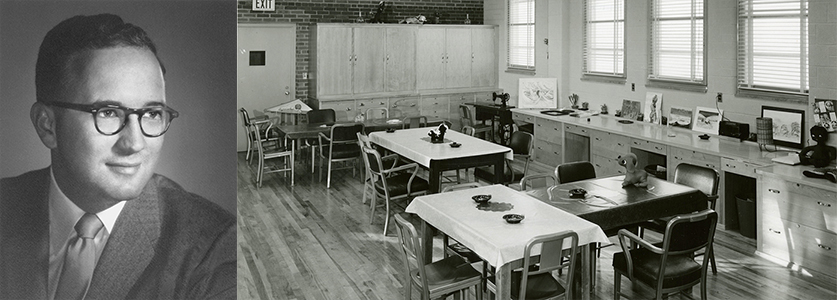
Public Health and Preventive Psychiatry
Dr. Elmer Gardner Chairs the Department
Early development of the focus on Public Health and Preventive Psychiatry distinguished URMC Department of Psychiatry nationally and internationally. Establishment of the Division of Preventive Psychiatry under the direction of Dr. Elmer Gardner.
Racial unrest and a rebellion in July brought in the National Guard, a watershed event in the history of Rochester forcing the community to confront racial disparities.
Josephine Cobb, RN, and Robert Mitchel, RN, were named supervisors of psychiatric nursing in the department for the following inpatient psychiatric units: R-2, R-3, R-4, and X2 in the Municipal hospital during the 1960s.
1967
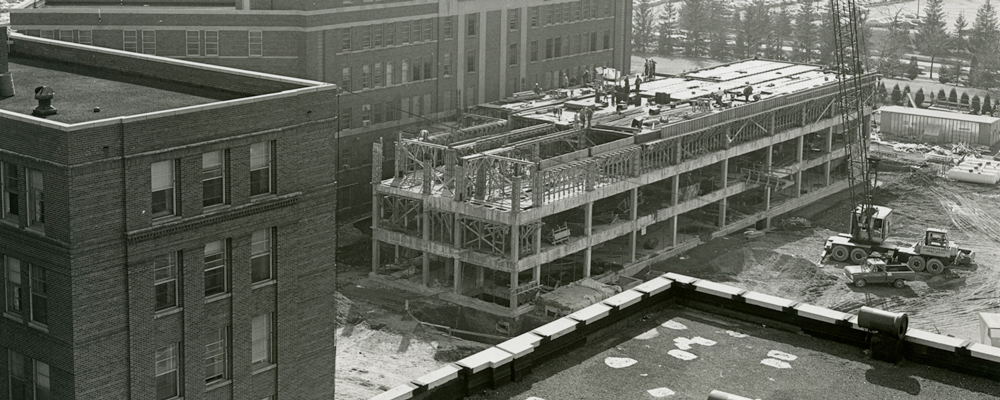
The Family Movement Begins
Community Mental Health Center
Groundbreaking of the Wing R North in the Department of Psychiatry.
The family movement in the department began in the late-1960's. Rodney Shapiro, Ph.D., in collaboration with social worker Elta Green, created a family therapy training program in 1971. The family training program would become mandatory for all psychology trainees and psychiatric residents.
A Community Mental Health Center (CMHC) is integrated into the Department of Psychiatry.
Family Therapy and Community Mental Health
1971
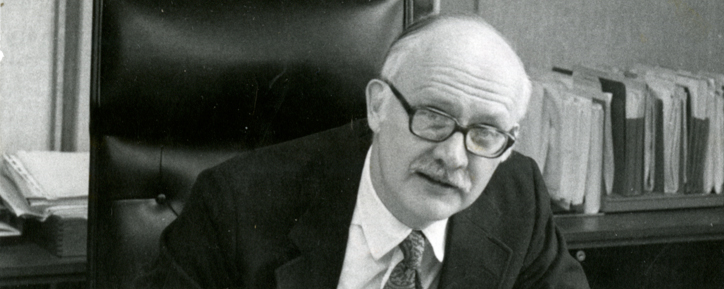
Dr. Lyman Wynne Chairs the Department
Innovations in Family Therapy and Schizophrenia
25th Anniversary of the Department of Psychiatry is Celebrated
Dr. Lyman Wynne succeeds Dr. Romano as Chair of the Department of Psychiatry. In the field of family therapy, Dr. Wynne was among the most outstanding innovators and mentors who laid the foundation for family-based therapies both nationally and internationally. His life was devoted to understanding and alleviating the suffering of patients with schizophrenia and the burdens that their family members experienced
Arriving in Rochester from the National Institute of Mental Health (NIMH) as a recognized leader in family therapy and schizophrenia, Dr. Lyman Wynne was appointed Chair of the Department of Psychiatry at the University of Rochester Medical Center (URMC) during the department’s 25th year. Dr. Wynne led the department from 1971 until 1977 when he stepped down as Chair to focus on family therapy and research.
Dr. Wynne had a long history of contributing nationally, which included his work with the NIMH in the 1950s and 60s as well as a leadership role as President of the American Family Therapy Association from 1986-87. In the field of family therapy, Wynne was among the greatest innovators and mentors who laid the foundation for family-based therapies both nationally and internationally.
In 1997, Dr. Wynne co-founded (with his wife, Adele, also a therapist) the Wynne Center for Family Research at URMC that continues to thrive today. In his final annual report, Dr. John Romano applauded the appointment of Dr. Wynne, his successor, stating, "His record as a scientist and as a clinician assures the further growth and development of the department . . ." a prediction that has borne true.
The Department of Psychiatry celebrated its 25th Anniversary in 1971.
View the 25th Anniversary conference documents .
1973 - 1974
Methadone Maintenance Treatment Program (MMTP) Begins
The Methadone Maintenance Program is instituted by social worker Judith McKay and Dr. Haroutun Babigian, MD, director of CMHC.
In 1974 the The Department of Psychiatry merged with Strong Memorial Hospital.
1976 -1977

The Epidemiological Registry is Created in Rochester
Dr. Haroutun Babigian is the Department Chair
Dr. Haroutun Babigian, MD chairs the Department of Psychiatry and creates the first epidemiological registry in Rochester and the first capitated payment system for mental health in the USA.
The Department welcomed the first deaf psychology intern in 1976.
1979
The Extended Care Clinic is Established
The Extended Care Clinic is established within the Community Mental Health Center (CMHC) for severely mentally ill adults run by nurses Peg Bushey and Louise Roden. The Department of Psychiatry begins laying groundwork for integrated mental health.
1980

The Birth of Medical Family Therapy
The Emergence of Forensic Psychiatry
Susan McDaniel, PhD fosters the “birth” of Medical Family Therapy and Family-Oriented Primary Care along with an MFT integrated care training program. Under the direction of Dr. J. Richard Ciccone the department provided national leadership in the development and emergence of Forensic Psychiatry.
1983
Family Therapy Education and the Alzheimer's Clinic
The Family Therapy Training Program is established integrating the Biopsychosocial model with Transitional Family Therapy. Alzheimer’s Clinic is started as a joint venture with Neurology and Psychiatry led by Dr. Robert Joynt and Dr. Eric Caine.
1985

The Geropsychiatry Clinic and Behavioral Health Services at Highland Hospital
Dr. David Bonacci establishes and lead the Geropsychiatry Clinic. Behavioral Health Services are deployed to Highland Hospital.
1986
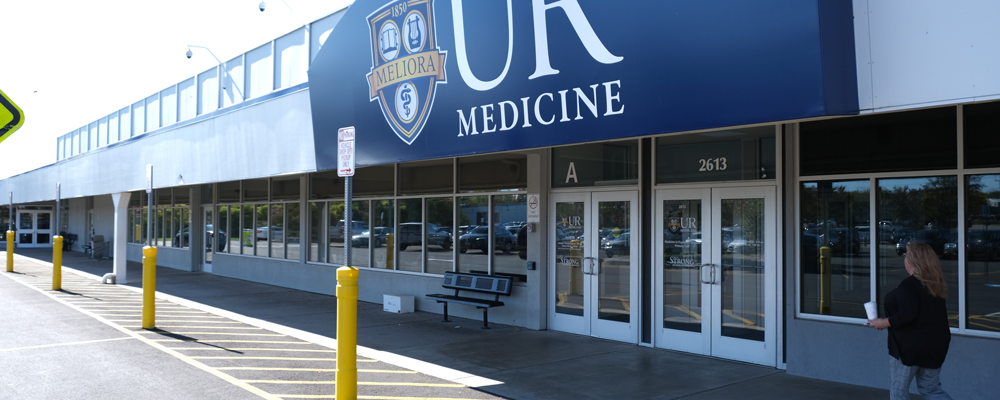
Strong Ties Begins
Alcoholism and the Drug Dependency Program (ADDP) is Established
The Alzheimer's Disease Care, Research and Education Program (AD-CARE) is initiated.
The nation’s first capitated payment system for severely and persistently mentally ill adults is piloted under the Monroe Livingston Demonstration Project which became Strong Ties Community Support Program in 1988.
Alcoholism and Drug Dependency Program (ADDP) opens, initiated by Rob Shea, CASAC and Bob Klein, MD
The Alzheimer's Disease Care, Research and Education Program (AD-CARE) begins conducting, directing, and consulting in clinical trials for Alzheimer's Disease and Dementia in 1986, including several landmark trials.
Visit the AD-CARE website for more information.
1988

The Laboratory of Suicide Studies Begins
In 1999 the Laboratory will become The Center for the Study & Prevention of Suicide (CSPS).
1990

The Beginning of the Deaf Wellness Center and Strong Recovery
In 1999, the Deaf Wellness Center is founded and directed by Dr. Robert Q Pollard, Jr. The Alcohol and Drug Dependency Program is merged with the Methadone Maintenance Treatment Program and renamed Strong Recovery in 1995 under the direction of Dr. Gloria Baciewicz.
Deaf Individuals and their families are treated by deaf and bilingual clinicians in what would later become the “The Deaf Wellness Center”. The DWC is focused on mental health care, training, and is a leading research site in the U.S. regarding issues affecting the Deaf community.
1992

Expanding Degree Programs and the Beginning of Child & Adolescent Inpatient Services
M.S. degree in Marriage and Family Therapy Education Program established. Child & Adolescent inpatient services opens and expands in 2002.
Innovation & Culturally Relevant Care
1993

The Medicine in Psychiatry Service and Dr. Eric Caine
Dr. Roger Boulay and Dr. Telva Olivares begin providing preventive medical care to severely and persistently mentally ill individuals at our Strong Ties Clinic. Later in 1999 MIPS officially becomes a billable service through the Department of Health. Dr. Eric Caine becomes the Chair of the Department of Psychiatry.
Dr. Caine's leadership sparked the growth of scholarship and research throughout the Department, while promoting cultural awareness, community-based treatment of serious mental illness, integration of primary medical care and behavioral health, and the study and prevention of suicide.
1996
The Employee Assistance Program Begins
50th Anniversary of the Department of Psychiatry is Celebrated
In 1997, the Employee Assistance Program (EAP) begins working with the Rochester Fire Department. EAP services are expanded in 1998 to support University of Rochester employees. The Department of Psychiatry Celebrates 50 years. View 50th Anniversary Celebration booklet
1997

The Wynne Center for Family Research and Child & Adolescent Partial Hospitalization Opens
Dr. Lyman Wynne, with his wife, Adele, also a therapist, co-founded the Wynne Center for Family Research at URMC that continues to thrive today.
The Child & Adolescent Partial Hospitalization program is the only program of its kind in the Upstate New York area.
1999

The Lazos Fuertes Outpatient Clinic Opens
Led by Dr. Telva Olivares, Lazos Fuertes, a bicultural/bilingual outpatient clinic, opens to improve the health of the Rochester Hispanic community led by Dr. Olivares.
Cultural Competence and Diversity Strategic Plans are developed by the Department of Psychiatry.
1999 - 2000
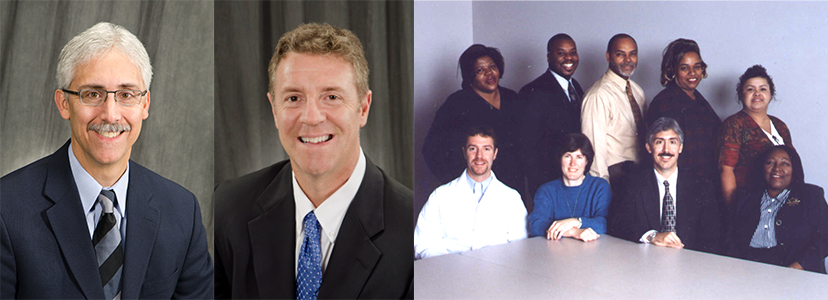
Forensic Assertive Community Treatment Initiated
The Rochester Forensic Assertive Community Treatment model (R-FACT), lead by Dr. Steve Lamberti and Robert Weisman, a nationally recognized, groundbreaking model of care was initiated.
The Rochester FACT model is designed to prevent criminal recidivism and to promote recovery among justice-involved adults with schizophrenia and related disorders through mental health and criminal justice collaboration.
URMC Newsroom Article - Keeping Mentally Ill Out of Jail and in Treatment: Rochester Model Works in Breakthrough Study
Lamberti, J. S., Weisman, R. L., Cerulli, C., Williams, G. C., Jacobowitz, D. B., Mueser, K. T., Marks, P. D., Strawderman, R. L., Harrington, D., Lamberti, T. A., & Caine, E. D. (2017). A Randomized Controlled Trial of the Rochester Forensic Assertive Community Treatment Model. Psychiatric services (Washington, D.C.), 68(10), 1016–1024. https://doi.org/10.1176/appi.ps.201600329
2002 - 2003

The Laboratory for Interpersonal Violence and Victimization (LIVV) is Founded
Senior Health and Research Alliance is Established
Catherine Cerulli, JD, PhD, founded the Laboratory for Interpersonal Violence (LIVV) and Yeates Conwell establishes the Senior Health and Research (SHARE) Alliance.
Dr. Cerulli, JD, PhD, founded the Laboratory for Interpersonal Violence (LIVV) in 2002 to improve violence prevention and intervention efforts, nationally and internationally, through research, education, and advocacy initiatives.
In 2003 the Senior Health and Research (SHARE) Alliance was established by Dr. Conwell with Community Partners to develop novel evidence-based models of integrated care for older adults and those who care for them.
2006
The Behavioral Medical-Surgical Unit (BMSU) Opens
The Department of Psychiatry's Advisory Council of Consumers (DPACC) is Formed
The Behavioral Medical-Surgical Unit (BMSU) provides integrated inpatient care for patients with mental illness and co-occurring medical illness. In 2017 the BMSU was renamed the “Inpatient Medicine in Psychiatry Unit” to better reflect the mission of providing acute medical care that is tailored and targeted to the biopsychosocial needs of patients with severe mental illnesses.
The Department of Psychiatry’s Advisory Council of Consumers (DPACC) becomes a nationally recognized council for its effectiveness in shaping patient and family-centered care in Psychiatry.
2011
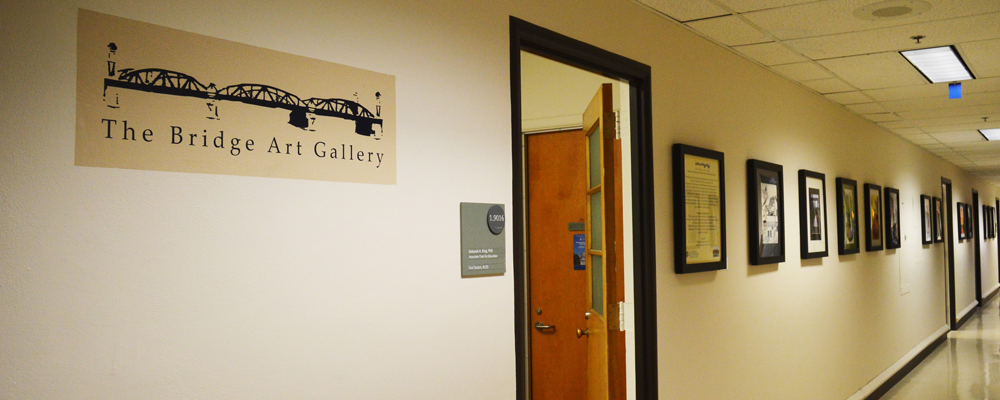
The Bridge Art Gallery Opens to the Public
The Department of Psychiatry’s Bridge Art Gallery opens, a community gallery designed to reduce the stigma of mental illness and mental health care. Visit the Bridge Art Gallery webpage for more information.
2013 - 2015
Leveraging Technology with Telepsychiatry and Project ECHO®
Behavioral Health Partners is Created
UR Medicine’s Telepsychiatry program, Project ECHO® and Behavioral Health Partners begins.
UR Medicine’s Telepsychiatry program and Project ECHO®, leverages technology to provide health care at a distance within rural hospitals, primary care practices, and skilled nursing facilities.
Behavioral Health Partners, a mental health resource for the University of Rochester employees, retirees, and adult dependents is created in 2014.
The URMC Department of Psychiatry doubled the number of psychiatric residents to eight in 2015.
2016

The HEAL Collaborative is Established
Drs. Catherine Cerulli, JD, PhD (LIVV) and Dr. Ellen Poleshuck, PhD, along with co-workers in the Psychiatry Department and community partners, worked together to begin the HEAL Collaborative, the groundbreaking program Healing through Education, Advocacy, and Law (HEAL).
HEAL provides mental health, legal, and social services - in the same place, at the same time - to individuals who are 18 years of age and older to help ensure safety and well-being. Visit the HEAL website for more information.
Celebrating the Biopsychosocial Model
2017

The Laboratory of Behavioral Health Skills is Established
Dr. H. Benjamin Lee is the New Department Chair
The Laboratory of Behavioral Health Skills is established by Dr. Wendi Cross and Steve Fasone with support and input from Dr. Ben Lee for hands on learning and competence assessment. H. Benjamin Lee, MD becomes the chair of the Department of Psychiatry.
While overseeing significant growth in Department faculty and services, Dr. Lee's leadership reinvigorates the application of Engel’s biopsychosocial model to the integration of medical and behavioral health services and emphasizes diversity and inclusion in the workplace and in care delivery.
Publication of the first NIMH-funded randomized controlled trial of FACT.
2019
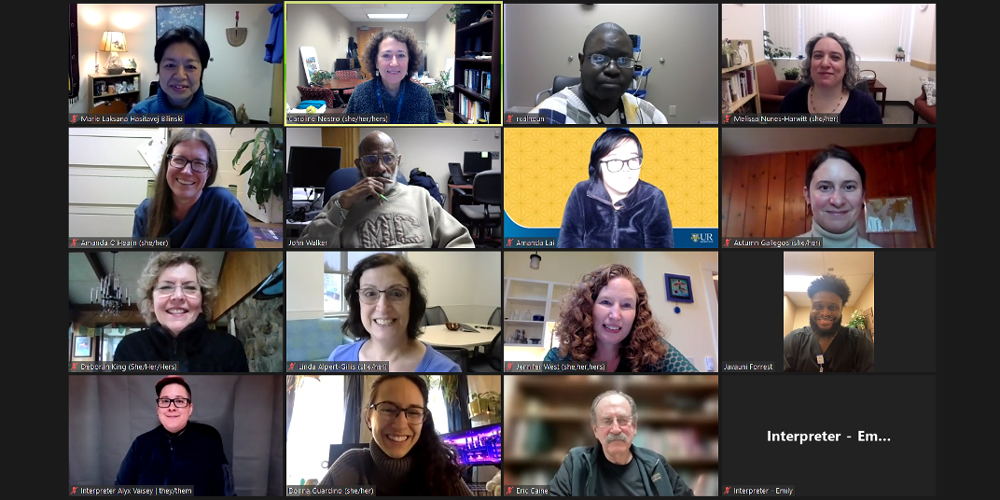
The Office of DICE Established
The Department of Psychiatry’s Office of DICE is created following many years of departmental equal opportunity work dating back to 1990.
Core Values of the Department of Psychiatry
The Department of Psychiatry with over 1500 faculty and staff members, is committed to improving the well-being of all the communities we serve, including patients, their families, our workforce, and the surrounding community. This commitment guides the implementation of our four mission areas of Education, Clinical Care, Research and Community Engagement. Visit the DICE webpage for more information.
2020

The Relocation of Wellness Adult Outpatient Services
Golisano Pediatric Behavioral Health Opens New Building
Mental Health & Wellness Adult Outpatient Services moves downtown. The new Golisano Pediatric Behavioral Health building brings outpatient and partial hospitalization services under one roof.
The relocation of our Adult Outpatient services, including Lazos Fuertes, to N. Chestnut Street, in the heart of the city for greater accessibility to the community.
The Golisano Pediatric Behavioral Health children and adolescent outpatient and partial hospitalization services adds more intensive outpatient services which will allow children to receive a higher level of care while still attending regular school and living at home.
2021

First-of-Its-Kind SUMMITS inpatient Medical-Psychiatry Unit Opens
In July of 2021, the Department of Psychiatry opened The SUMMITS (Substance Use, Medical Management, Infection Treatment, and Support), a new 10-bed inpatient medical-psychiatry unit to provide specialized care and mental health resources for hospitalized individuals who have a co-morbidity resulting from substance use disorders.
The SUMMITS unit is thought to be the first of its kind in the nation. The new model stems from a Pursuing Excellence project that identified a need for less-stigmatized care. The new unit grew directly out of a quality improvement work facilitated by the LISCN lab and led by the Inpatient Medicine in Psychiatry (IMIP) unit director Marsha Wittink, MD, MBE, Nurse Manager Heather Jackson, MS, RN-BC, and lead Nurse Practitioner Lorraine Schild, MSN, ANP.
The model includes embedded SUD counselors and peers, a dedicated social worker, and a dual-boarded Psychiatrist/Internist Kirk Harris, MD as its medical director. The same dedicated nursing and provider staff who care for patients on the IMIP unit also care for SUMMITS patients. Like the IMIP unit, the goal of SUMMITS is to help provide comprehensive biopsychosocial care and an important bridge to outpatient services within the department.
2022
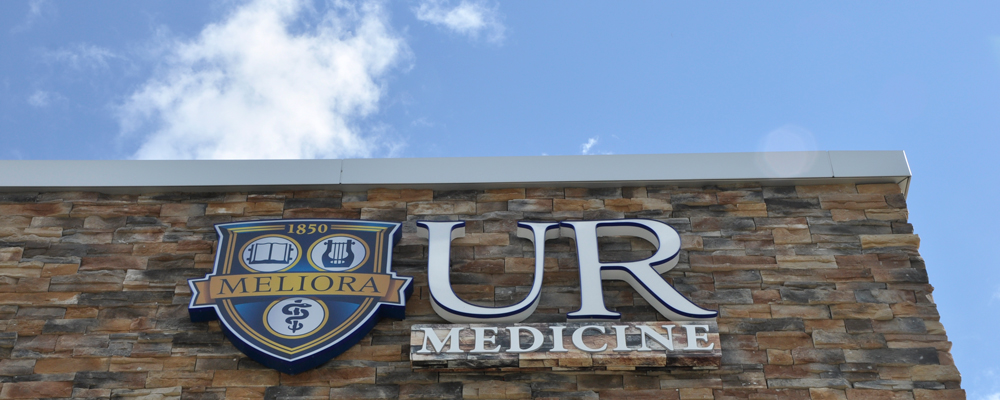
75th Anniversary of the Department of Psychiatry
Celebrating the Biopsychosocial Model
Our 75th celebrations and activities provided a chance for faculty, staff, alumni, department partners, supporters, and the community to come together. We celebrated past accomplishments, reflected on missed opportunities, and imagined what is possible for the department’s next 25 years.
2023

Geriatric Mental Health and Memory Care Open House
In October 2023, the Division of Geriatric Mental Health and Memory Care hosted an open house and ribbon-cutting ceremony for its new Science Parkway service location. Over 100 community members and UR Medicine employees visited to celebrate the new spaces for the Alzheimer's Disease Care, Research and Education Program (AD-CARE), the Memory Care Program, and the upcoming infusion site for Alzheimer's medications.
Learn more about the Geriatric Mental Health and Memory Care
2024

New Pediatric Mental Health Urgent Care Center Opens
Golisano Children's Hospital opened the new Brighter Days Pediatric Mental Health Urgent Care Center, the area’s first-ever walk-in mental health clinic for young people up to the age of 18. This initiative is supported by $1 million from the Brighter Days Foundation.
 “There are no clinics like this outside of the New York City region, and we’re thrilled that we will be able to provide this vital service for thousands of children in Western New York." said Michael Scharf, MD, psychiatrist-in-chief at GCH.
“There are no clinics like this outside of the New York City region, and we’re thrilled that we will be able to provide this vital service for thousands of children in Western New York." said Michael Scharf, MD, psychiatrist-in-chief at GCH.
Read Full UR Newsroom Article
View the Ribbon Cutting live stream of the Brighter Days Pediatric Mental Health Urgent Care opening